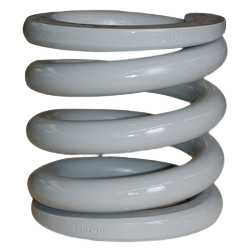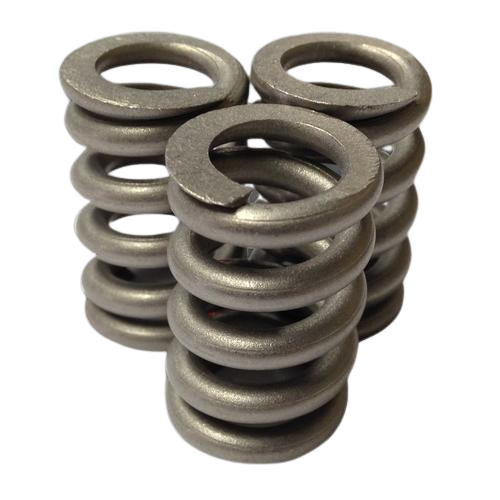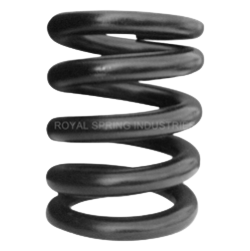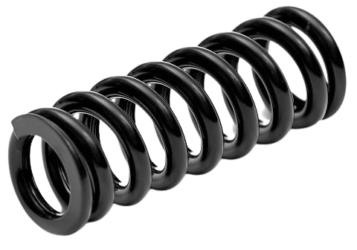Coil Spring




Coil Spring manufacturers :
We are leading Coil Spring manufacturers up to the manufacturing capacity :
- Wire Dia. : upto 70 mm.
- Outer Dia. : upto 500 mm.
- Free Height : upto 1000 mm.
- Total Coils : As per user’s requirement.
- Load capacity : upto 40 Tons. (per pc.)
Raw-material grades :
We are Coil Spring manufacturers with different types of Alloy Steel grades (Spring Steels). Raw-material grade is critical for ensuring proper mechanical performance, durability and fatigue resistance. Here’s a breakdown of the most common raw-material grades used :
- BS:970 EN-42
- BS:970 EN-45
- BS:970 EN-47
- 50Cr.V4
- 50Cr.4V2
- 51Cr.V4
- 50Cr.MoV4
- 50Si7
- 55Si7
- 60Si7
- SUP-9
- SUP-9A
- SAE-5160
- IS:4454 Part-1 Grade-2
- IS:4454 Part-1 Grade-2D
- Stainless Steel
- others similar foreign grades JIS, ASTM etc.
Painting & Coating :
We are Coil Spring manufacturers & suppliers with different types of paintings and coatings. The choice is depends on the application, environmental exposure and aesthetic requirements. Some of common types are :
- Synthetic Enamel Paint
- Powder Coating
- Phosphate
- Zinc Coating
- etc.
Manufacturing process :
We are heavy duty Coil Spring manufacturers. Know the manufacturing process step-by-step here :
- Raw material procurement
- Raw material dimension checking
- Raw material Chemical testing
- Centre Less grinding
- Both ends Forging
- Bar heating in furnace at approx. 950º C
- Coiling on coiling pitching machine
- Oil quenching for Hardening
- Tempering in furnace at approx. 450º C
- Scrag testing
- Height checking
- Ends grinding
- Dimension checking
- Load testing
- Shot peening
- Surface oiling
- Painting
- Coating
- Packing
- Delivery
Coil Spring types :
Coil Spring types are depending on their shape, function and application. Some common types are described here :
Helical Compression Spring :
A Helical Compression Spring is a Coil Spring types and a mechanical device made from a wire coiled into a helix (spiral) shape, designed to resist axial compressive forces. When a load is applied, the spring contracts (shortens) and stores potential energy, which is released when the load is removed, allowing the Spring to return to its original length.
Extension Spring :
A Extension Spring is a Coil Spring types, designed to absorb and store energy by resisting stretching. It operates by pulling back when its ends are pulled apart, generating a restoring force that attempts to return the Spring to its original, tightly coiled position.
Volute Spring :
A Volute Spring is a Coil Spring types made from a flat metal strip that is wound into the shape of a cone or spiral, resembling a seashell or volute. Unlike traditional round-wire Coil Spring, a Volute Spring compresses by sliding the coils over each other, allowing it to become more compact when compressed.
Coil Spring design :
Coil Spring design is based of it’s application, load capacity, working area and functionality. Some common designs are :
Open ends :
An open ends Coil Spring design is a type of Spring in which the ends of the coils are left unfinished, means they are not flattened, squared or ground. The coils simply terminate naturally at their final turn without any special treatment and mostly used for Compression Spring and Extension Spring.
Closed ends :
A closed ends Coil Spring design is a type of Spring in which the last coil at each end is bent to touch the adjacent coil, creating a more stable and compact ends than an open-ended Spring. However, the ends are either grounded or not grounded, mostly used to prepare a Helical Compression Spring.
Pigtail ends :
A pigtail ends Coil Spring design is a type of Spring, where one or both ends are tapered to a smaller diameter, resembling a pig’s tail. The tapering helps the Spring seat securely into a smaller Spring pocket or mounting surface, usually applicable for a Compression Spring.
Coil Spring application :
Coil Spring application in mechanical components that store and release energy, absorb shock, maintain force, or control motion. Their versatility makes them essential in many industries from automotive and aerospace to consumer products and industrial machinery. Some applications are described below :
Automobile suspension :
Coil Spring is one of the most common types of Spring used in Automobile suspension systems. The Coil Spring’s application a vital role in absorbing shocks, supporting vehicle weight and maintaining tire contact with the road for safety and comfort. We are Coil Spring manufacturers for all types of Automobile for Cars & Bikes suspension system.
Railway Bogie / Wagon :
Railway Bogie Coil Spring is category of Helical Compression Spring. The Coil Spring’s application here as a component for absorbing load, bumping shock, jerk and protect direct damage on Railway Boogies. This Coil Spring is a safety item for Railway and essential component for passenger coach, locomotive and freight wagon for safe running on rail track. We are Coil Spring manufacturers & exporters for Railway Bogie Springs for worldwide.
Railway Pantograph :
Coil Spring application in Railway Pantograph plays vital role for it’s constant function. Pantograph is a component which connect the electricity with EMU, VEMU, Electric Loco placed on the roof for constant electric power connection to coaches and locos while running on track. Pantographic barrel is a important component of Pantograph which works in support of one set of Coil Spring installed inside the barrel to perform constant static function to connect the overhead high tension electric wire. This set of Coil Spring consists of 3 different types – outer, intermediate & inner Spring. We are Coil Spring manufacturers of Railway Pantograph from smaller to heavy section.
Railway Buffer :
Buffer Spring is under the category of Coil Spring. This Spring is manufactured from round and flat section spring steel. It is horizontally or vertically filled inside Buffer casing in single or double pcs. as required. Also Buffer Spring placed openly depending on circumstances of requirement. Railway Buffer Coil Spring is placed horizontally and vertically for application to lift/elevator and other purposes. The Coil Spring application as Buffer Spring performs to resist and absorb sudden heavy shock.
Railway Coupler :
Coupler Spring is under the category of Coil Spring. This is manufactured from round and taper flat or flat section as per designs. The Coil Spring application is to safely draw or pull any other component absorbing the complete loads and weight to resist any damage on the working area. Railway Coupler Coil Spring is filled horizontally with coupling hook and draw bar to draw and pull next coach or wagon by linking each other. We are Coil Spring manufacturers for Railway couplers for worldwide Railways.
Crusher machine :
Cone & Jay Crusher machines are consist of heavy duty Coil Spring. The Coil Spring application performs a vital role in Crusher machine for crushing & breaking coal, stone and differing mine ores. Crusher Coil Spring is generally designed specially light up to extra heavy category. Crusher Spring absorb constant heavy pressure, jerk, shock when in functions. This type of spring requires special heat treatment to avoid failure using suitable grade of steel. We are heavy duty Coil Spring manufacturers for all types of Crusher machines.
Vibrator Screen :
Vibrating Screening machine Spring is typically a Coil Spring. The Coil Spring application is necessary here to function on continuous vibration on the machine to segregate the crushed objects of crusher machine to different sizes in support of metal net. Screening machine Spring is manufactured from the spring steel conforming to BS-970 En-45 & EN-47 depending on the working volume & nature of machine and designed to match suitably. Accordingly Coil Spring is also designed light & heavy type for proper performance to meet requirement. We are Vibrating Screen Coil Spring manufacturers upto most heavy section with custom dimension.
Valves :
Valve Spring is one type of Coil Spring made from wire or bar as required in different shapes. The Coil Spring application in the Valve to mainly control the pressure and vibration in working condition. Valve Coil Spring has responsible part of job for safety of the component where fitted for the purpose. Spring loaded valve is used in general engineering equipment, automobile, gas, air and water flow line etc. We are Valve Coil Spring manufacturers upto most heavy section as per demand.
